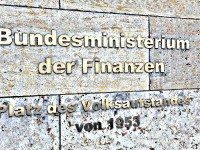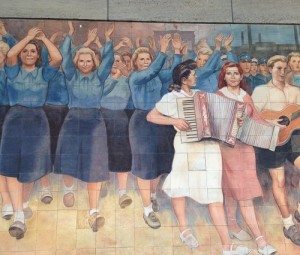
It was conceived as the Ministry of Aviation, the “Reichsluftfahrtministerium”, and has 2,000 offices and about 603,000 square feet. This was Berlin’s largest office building but, unlike the skyscrapers in American cities of that time, it has only five stories, but several courtyards and a huge hall, three stories high. At the main entrance is a large cour d’honneur like in a castle. The shape of the building has more in common with a traditional European palace, that with a modern office building.
The ministry combined civil and military aviation, namely the reorganization of the German Air Force after the restrictions for Germany as a consequence of World War I. Hermann Göring, Minister for Aviation and a pilot of the German Air Force or “Luftwaffe” in World War I got also hold of the German aircraft industry and aerial defense. Clearly, this ministry was conceived to prepare another war.
+++You might also be interested in our free self-guided Berlin Mitte West tour. The Potsdamer Platz, the Checkpoint Charlie, and the exhibition Topography of Terror are also nearby in walking distance. +++
Modern Architecture in the 1930s
Even though modern architecture was banned in Nazi-Germany, the “Reichsluftfahrtministerium” is a modern building. The architect, Ernst Sagebiel, used steel framework and reinforced concrete. The shell limestone and the relatively small windows with a traditional German crossbar pretend traditional crafts. The building was also a public project to create work and it was finished in less than two years. In this aspect it was part of the NS propaganda of economic recovery. Later, Ernst Sagebiel was responsible for the construction the Berlin Airport Tempelhof, then the largest building in the world. The airport was only finished after World War II and is now out of service. Sagebiel, who spent his career during the Third Reich designing buildings for aviation in Berlin and other German cities, cultivated a relatively simple and functional architectural style, which is referred to as “air force modernism”.
After the war, the “Reichsluftfahrtministerium” found itself in the Soviet occupation zone and October 7th 1949, the German Democratic Republic (GDR) was officially founded in this building. The new socialist state used it as the “House of the Ministries”. The government commissioned a 24 x 3 meters (75 x 9 feet) mural made of tiles (China from the traditional factory in Meißen) and named “Aufbau der Republik” (“Constitution of the Republic”) which is still there and landmarked.
After Unification of Germany
After the unification of Germany, it was the seat of the “Treuhandanstalt”, (“trust agency”), the agency in charge of privatizing the East German enterprises that had been nationalized. The first CEO of this “Treuhandanstalt”, Detlev Rohwedder, was assassinated by an allegedly left extremist terrorist in April 1991. Later, the “Treuhandanstalt” moved to another building at the Alexanderplatz and its former seat was named “Detlev Rohwedder Building”. After some years of renovation, the former Ministry on Aviation now houses the Federal Department of Finance. The administration of the “Bundesrat” (the second chamber of the German Parliament) with its main building just around the corner on the Leipziger Straße is in the adjacent wing of the “Reichsluftfahrtministerium”.
Memorials

In the 1970s, the GDR-government honored the German officer Harro Schulze-Boysen with a memorial in his former office. Harro Schulze-Boysen, who had worked in the “Reichsluftfahrtministerium” and spied for the Soviet Union in the hope to accelerate a victory over Hitler, was executed in 1942.
In June 17th 1953, there was an uprising of workers of the construction site of the Stalinallee (today Karl-Marx-Allee) that spread all over the country and was brutally suppressed by the East German police forces and Soviet troops. One demonstration took place at the “House of the Ministries”. Today, there is a memorial at the building, on the corner of Leipziger- and Wilhelmstraße.
The “Reichsluftfahrtministerium” is one of a few NS-buildings in Berlin that are used for public administration in Berlin. Its plain functionality made it apt for different political systems.
++On our Berlin-in-a-in a day-Walking Tour we’ll stop by the former Ministry on Aviation.++




